Within Sulawesi, one of the least developed areas is SE Sulawesi Province, which consists of twelve districts, comprising ten regencies and two towns, including Kendari which is the major population and commercial centre.
SE Sulawesi is a relatively impoverished region of Indonesia. The fishery related activities are of importance to this region and currently estimated to account for about 12 percent of the annual GDP, to which mariculture contributes approximately 3-4 percent. In 2007 aquaculture production in the Province reached 153,160 t, valued at approximately 1000 billion Indonesian Rupia, with seaweed production showing the highest growth. A total of 115,483 households and 160,140 persons were involved in aquaculture in the Province.
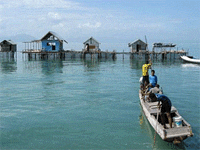
SE Sulawesi and the associated islands have many accessible and well sheltered bays and inlets with abundant natural resources for mariculture, including good water quality. Resident coastal communities are eager to increase their quality of life through adoption and development of commercial production systems for various local products including grouper, seaweed, lobster, abalone, pearl oyster and sea cucumber.
Mariculture and fisheries development is often seen as an important strategy to contribute to poverty alleviation of rural coastal communities. The Government of Indonesia, having recognized this fact, is in the process of initiating development activities in partnership with the Australian Government through the 'Smallholder Agribusiness Development Initiative' (SADI). The purpose of this initiative is to reduce poverty and improve livelihoods for smallholders in eastern Indonesia. The Australian Centre for International Agricultural Research (ACIAR) coordinates the 'Support for Market Driven Adaptive Research' (SMAR) sub-program of SADI.
SMAR is a sub-program of the larger 'Smallholder Agribusiness Development Initiative' of the Australian and Indonesian governments designed to address long-standing issues and constraints relating to agricultural production and rural poverty in Eastern Indonesia. The purpose of SMAR is to develop strengthened, province-based agricultural R&D capacity that is market and client-driven and effectively transferring knowledge between stakeholders.
This article provides a brief introduction to mariculture activities for selected species in Kendari Bay, one of the main production regions in SE Sulawesi. It also outlines a new ACIAR-SADI funded project entitled 'Mariculture Market Chain Development in SE Sulwesi' being undertaken on a collaborative basis by Haluoleo University and the provincial fisheries service in SE Sulawesi, the Indonesian Centre for Marine and Fisheries Socio-Economic Research, the Network of Aquaculture Centres in Asia-Pacific and the Victorian Department of Primary Industries, Australia.
Grouper farming
Grouper farming is one of the most popular mariculture activities in the Kendari region. The main species farmed are the mouse grouper, Cromileptes altivelis, tiger grouper Epinephelus fusgoguttatus and possibly greasy grouper E. tauvina. The farming activity essentially consists of the fattening of 5-7cm fingerlings, most of which are procured from hatcheries in Situbondo, Java and from Bali Island. The price of fingerlings is based on the length; a 1 cm fish costing around 3,000 Rp on delivery at the site.
Monthly changes in live grouper production in SE Sulawesi, the total revenue and price per kg in 2007. Based on data from Dinas Kelautan Dan Perikanan (Provincial Fishery Service).
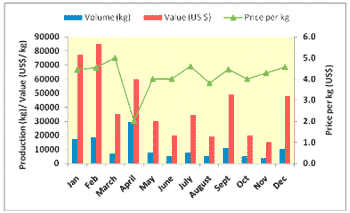
The grouper are fattened in net cages (5 x 5 x 3m), of wooden or bamboo frames; each farmer owning and managing up to four-six cages. They are fed small, low-valued fish species, more often than not caught by the farmers themselves by gill netting, or from fixed weirs erected by the farmers (locally known as sero). The latter is a traditional mode of fishing, with the weir ownership passing hands from generation to generation. During the peak season, 50-80kg of fish are caught each day. Some of the larger operators obtain the low-valued fish through contracted artisanal fishers, purchased at around 12,000-20,000 Rp/kg, depending on the season.
Almost all farmed grouper are exported live to Hong Kong. Fish are harvested at a size ranging from 0.5 to 0.75 kg. Live haul boats arrive in the region on a regular basis and all transactions are cash-based.
Farming of grouper occurs through the year, with a peak period from December to March. In general, the farm-gate price of live grouper is relatively static through the year, with a marginal increase during February- March, the time of the Chinese New Year, and a rapid drop in the following month e.g. the price in the live fish restaurant trade in Hong Kong and Singapore ranges from about US $ 14 to 20, depending on the season and the species, as compared to the average farm-gate price of US$ 5 / kg. Mouse grouper often commands a 20-30% higher price than the tiger grouper. Interestingly, the almost complete dependence of SE Sulawesi grouper farming on hatchery-reared seed stock is heartening, especially from sustainability and biodiversity view points, and should be encouraged.
Spiny lobster farming
The most commonly farmed spiny lobster species is Panilurus versicolor. The type of cage used (5 x 5x 3 m), and the farming activity, including the procurement of low-valued fish for feed is very similar to that for grouper farming. However, in this instance the seed stocked, as in other parts of SE Asia, is wild caught. The wild seed stock supply is based on a tribe-based artisanal fishery in the waters surrounding the Tiworo Islands. The available seed stock are typically young lobster of about 100 g in weight (9-12 individuals/kg), costing 300,000Rp/kg (approximately US$10-12). They are fattened for 12-14 months and sold live to local wholesalers for export.
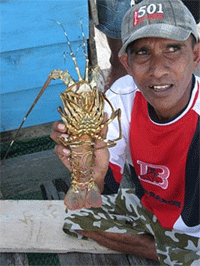
Lobsters are stocked at a density of 50 individuals/cage and harvested at a size of about 750-1000 g. The feeding of lobsters is well controlled, with each lobster typically being fed 1-2 small, low-valued fish per day. Most lobster farmers have their own sero (weir) for harvesting fish to feed lobsters. Lobster farmers also believe that putting papaya (Carica papaya) leaves and stems into the cages increases the moulting frequency and hence growth. Although indigenous knowledge may not necessarily be backed up by science, there may be a need to more closely investigate such an issue as a means of determining whether further improvements could be brought about in the spiny lobster production system.
The provincial fishery service (Dinas Perikanan) provided free seed stock to farmers in 2007 and 2008 through an Indonesian Government sponsored program to encourage lobster farming. The mortality rates in lobster farming are very low, and thus far disease problems have not surfaced. These factors have contributed to a significant shift to lobster farming from grouper. This shift has been further encouraged by the increasing cost of hatchery-based grouper seed, primarily brought about from increases in cost of transportation of seed over long distances.
Seaweed farming
Seaweed farming is a predominant activity in SE Sulawesi, largely because of the accessibility of protected inshore waters and the ideal ambient environmental conditions, the very low investment costs involved and strong market demand for the product. Although typically a lower valued product compared to other mariculture species, the farm-gate price of dried seaweed has more than doubled over the last several months, and currently ranges from 16,500 to 17,000 Rp/ kg. The commonly cultured seaweed is Kappaphycus cottoni (formerly Eucheuma). Unlike grouper and lobster farming, seaweed farming is typically a family activity, with all adults of the household being involved in one way or the other.
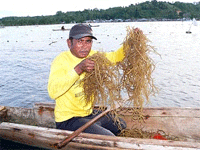
In the province, seaweed farming is conducted in community-based clusters, with each consisting of 10-15 (and up to 60) families managing/owning an area of about 1-2 ha/family. The harvesting season is June-December, with about four-five harvests/year, averaging 1-1.5 t (dry weight)/harvest. Although seaweed farming is currently profitable, it is also a farming system that is very environmentally friendly as it is carbon sequestering. In the recent past it has encountered some disease problems, in particular “ice-ice”, caused by reduced salinity from increased freshwater run-off into Kendari Bay. According to the farmers, two strains are farmed in the area, with one being faster growing and more resistant to disease. Farmers also believe that the quality of the available seed stock has deteriorated over the years.
Market chain and industry development
The new ACIAR project in SE Sulawesi is a scoping study with the objectives to:
- Facilitate local leadership and support for mariculture industry development
- Identify opportunities for adopting market driven, agibusiness approach to development for smallholders, and
- Prepare an industry development strategy with local stakeholder network.
Key initial activities for the project are to undertake a baseline survey to characterise and map existing mariculture supply chain dynamics in the province, with the emphasis being on a combination of high (abalone, grouper, spiny lobster, sea cucumber) and low-valued (seaweed) species and products in Kendari Bay and Buton and Muna Islands.
The existing supply chain (open diagram in new window) is heavily dependent on environmental inputs of water, nutrients, seed and feed, etc, and is traditionally structured in terms of the key 'production, distribution and consumer' sectors. It has limited information flow between the sectors, disproportionate sharing of the value of the products between supply chains participants and is constrained by limited inputs (e.g. seedstock), capital, infrastructure, skills and lack of a coordinated marketing strategy. On the positive side, natural resources are still plentiful/underexploited, diverse and relatively unmodified.
Local stakeholders are enthusiastic about the opportunities and have a desire to improve their livelihoods through consideration of strategic intervention and practice change. The scoping study is due for completion in mid 2009, at which time the feasibility will be determined of progressing to a 'stage 2 – market chain/industry development phase'.
A look into the future
The mariculture practices in the SE Sulawesi region are mostly simple, environmentally friendly, and can be considered as an ecosystem-based approach to mariculture, provided that the there is no over expansion and intensification in the foreseeable future. Perhaps one of the main drivers in this regard is that the practices tend to remain as a community-based activity, coordinated through village committees in such a manner that they are within the financial capabilities of the mostly smallholder farmers. A further strengthening of the village committees through enhanced networking, as well as forming clusters amongst villages, could lead not only to improvements in the practices per se but also enable market opportunities and improved trade of the farmed commodities.
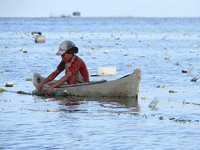
The mariculture farming systems in SE Sulawesi also provide a good opportunity to introduce “Better Management Practices” (BMPs) as had been done with commodities (Umesh et al., 2007) elsewhere, with encouraging results. The adoption of BMPs has lead to an improvement in overall production, reduced disease occurrence and better market access and farm gate prices, the latter being often an Achilles heel for small-scale farmers in relatively remote localities.
Finally, studies along the value chain, as the current project is evaluating, will be useful to bring about a more coherent trade of the farmed products in the region. Such steps will eventually lead to better farm gate prices, and also adoption of better, ecologically acceptable farming practices. Specifically, the ACIAR scoping study is investigating a new conceptual framework for developing the existing mariculture industry in SE Sulawesi. This will feature strategies for transforming the existing supply chain into a more functional market chain, underpinned by enhanced stakeholder networks and associated information systems, marketing strategies, risk management and capacity building. A community-based approach to trophically balanced mariculture, integrating the environmental benefits of seaweed farming with production of higher value products, has the opportunity to adopt an effective and distinctive market brand for the province. This will require substantial changes to existing supply chain characteristics and functions, led by private sector 'chain champions' working across production, distribution and consumer sectors, and in partnership with government, IGO/NGOs and tertiary sectors. In the longer term, the livelihoods of those coastal communities in SE Sulawesi involved in the mariculture industry will benefit greatly if sustainable industry development can be achieved, noting of course the inevitable emerging challenges from climate change, biosecurity threats and market globalisation.
References
Umesh, N.R., 2007. Development and adoption of BMPs by self-help farmer groups. Aquaculture Asia, XII (1), 8-11.
February 2009




